A portrait of: Elizabeth “Libby” Werner (b. c.1910 New York, NY – d. 1992 New York, NY)
Elizabeth “Libby” Werner was the great-grand daughter of Michael & Biddy Fagan. Libby’s father (Robert Werner b.1885 – d. 1962) was the older brother of Katherine “Katchie” Werner. Robert Werner was a watchmaker. In 1902 at the age of 17, he left the family home in Ferdinand, Indiana, and boarded the train in nearby Jasper, headed for Ames, Iowa to work as an apprentice to Cyril Oppermann, a watchmaker and family friend of Robert’s father, Dr. Axel Werner (b.1856 – d.1929). Doc Werner and Cyril were boyhood friends in Wiesbaden, Germany. When Robert arrived in Ames he took room and board above the watchmaker’s shop at the corner of Main Street and Kellogg. Robert met and fell in love with the boss’s daughter, 16 year-old Genevieve Oppermann (b.1885 – d. 1959). They were married on September 4th, 1905, at St Patrick’s Catholic Church in Dougherty Township by the Rev. John James Reilly of Mason City. When Robert finished his 7-year apprenticeship in 1909, he and his wife moved out of her father’s flat above the Oppermann Watchmaking Shoppe and moved to nearby Clear Lake where Robert opened his own watchmaking and repair business out of his 2 story home on Fir Street (later renamed Buddy Holly Place).

Young Elizabeth ‘Libby’ Werner
Robert and Genevieve were childless but adopted an orphan girl in 1917. The child, Elizabeth “Libby” Crawley, was seven or eight years old at the time she arrived on one of the so-called “Orphan Trains” in Mason City. The Orphan Trains were part of a social experiment that placed neglected, homeless, orphaned or abandoned city-dwelling children into the farms and homesteads of those in the agricultural mid-west and western plains. Accompanied by the Sisters of Charity from the New York Foundling, the children’s welfare agency in New York City, Libby was placed on a stage along with several other children that was set up in central Mason City near the train depot. The pre-screened applicants of farmers, homesteaders, and merchants inspected the children and were free to pick and choose any child or children they wished. Those not selected were herded back onto the train to await the next whistle stop. Later in life, Libby said she had no recollection of her time on the streets of New York City as a waif, or of the orphanage, but remembers placing her cardboard suitcase on the platform in Mason City and singing and dancing in her yellow pinafore in hopes that some sympathetic couple would choose her. Fortunately for Libby, Robert and Genevieve did and they provided well for her. Libby excelled in school and never lost her flair for performing. She was president of the drama club at Clear Lake High School and when she was 16 she was crowned Corn Harvest Queen at the Cerro Grotto County Fair in 1926 on the merits of her song and dance routine.
Libby left home the summer after graduation and headed straight for the bright lights of the Great White Way in New York City. The following year she made her first stage appearance as a last minute replacement tableaux vivant with the Ziegfeld Follies in the musical revue Sunny (1928) at the New Amsterdam Theatre. She later landed similar roles in the musical comedy Smiles (1930) starring Marilyn Miller and Fred Astaire and As Thousands Cheer (1933). When the overblown sets and curvaceous chorines of the 1920s moved to off-Broadway in favor of more sophisticated productions, Libby tried her hand at acting and got her first speaking role as “Bonnie”, a gangster’s girlfriend/sidekick in Cole Porter’s Anything Goes (1934) at the Neill Simon Theatre, starring Victor Moore and Ethel Merman. While living in West Midtown Manhattan, Libby met and married Stuart Kopecky, a city legal aid attorney who worked at a clinic in the West Village. They were married at the Actor’s Chapel, Saint Malachy’s Catholic Church, on 49th Street on May 23rd, 1938. To accommodate their friends, the couple was married on a Monday, the only day of the week the theatres on Broadway were dark.

Elizabeth ‘Libby’ Werner c.1931
Libby continued to work on and off-Broadway intermittently throughout the 1940s, most notably in Something for the Boys (1943), and as a frequently used understudy in Kiss Me Kate (1948). During the winter of 1951 Libby befriended Agnes Henderson, a young actress-singer-dancer who had recently arrived in New York and was attending the American Academy of Dramatic Arts. The two met at an audition at the Imperial Theatre for the production of Wish You Were Here. The young energetic actress reminded Libby of herself 25 years earlier. The two found they had much in common. Their families were both originally from southern Indiana and knew each other. In fact, Agnes’ doctor was Libby’s Uncle, Dr. Benjamin Werner (b.1890 – d.1961) in Ferdinand. Prior to their audition, Agnes graciously took some advice from the much more experienced Libby: to change her name from Agnes Henderson to the more stage-friendly Florence Henderson. The two would often attend Mass together at Saint Malachy’s until Florence landed the lead role in Fanny in 1954. Libby knew then her dear friend was on her way to the stardom that had always eluded her. They remained life-long friends.
By the late 1960s the curtain had come down on Broadway’s big theatrical musical productions. Television helped put an end to its glory, and the charming scores, quaint stories, and acclaimed performances were not enough to keep theatres lit or Libby employed. Her career came to a quiet close as houses gave way to rock operas. It was the “Age of Aquarius” and productions such as Hair and Oh! Calcutta ushered in a new, younger generation of performers and theatregoers.
Stuart Kopecky died in 1967 of lung cancer, and Libby, unable to afford living in their small apartment on West 48th Street, moved into the 8th Avenue Residence Hotel. When they tore down Madison Square Garden in 1968 the neighborhood quickly changed and the 1970s saw a complete decimation of her beloved Broadway and theatre district. The brightly lit theatres and streets teeming with tourists and theatre patrons in Times Square was once the pride of the city. Now, it had become a shamble of massage parlors, strip clubs, and porn shops. Many of the splendid old venues were torn down. Prostitution and drug dealing were seen regularly in the shadows and on the dimly lit corners, and the neighborhood became unsafe and unstable. The few remaining poor and elderly residents seemed under siege, held hostage in their own decaying apartments.
In 1976 the newly assigned pastor to St. Malachy’s, Father George Moore instituted new policies to minister to the remaining parishioners of the church, including the creation of the Encore Community Services to serve the needs of senior citizens. Its simple purpose was to improve the quality of life of the elderly residents in the Times Square/Clinton/Midtown communities. Encore provided seniors with healthy meals, shopping escorts, and social events in its church basement community center. Libby would often attend dances held in St. Malachy’s parish hall. It was there she met and rekindled a friendship with a widower by the name of Eddie Shea, a former off-Broadway character actor and bit player whom she had worked with at the New Century Theatre on 7th Avenue during the 1948 run of Kiss Me Kate. The two were married in 1984, at – where else? – St. Malachy’s Hall.
Read More
St. Malachy’s Catholic Church, NYC

